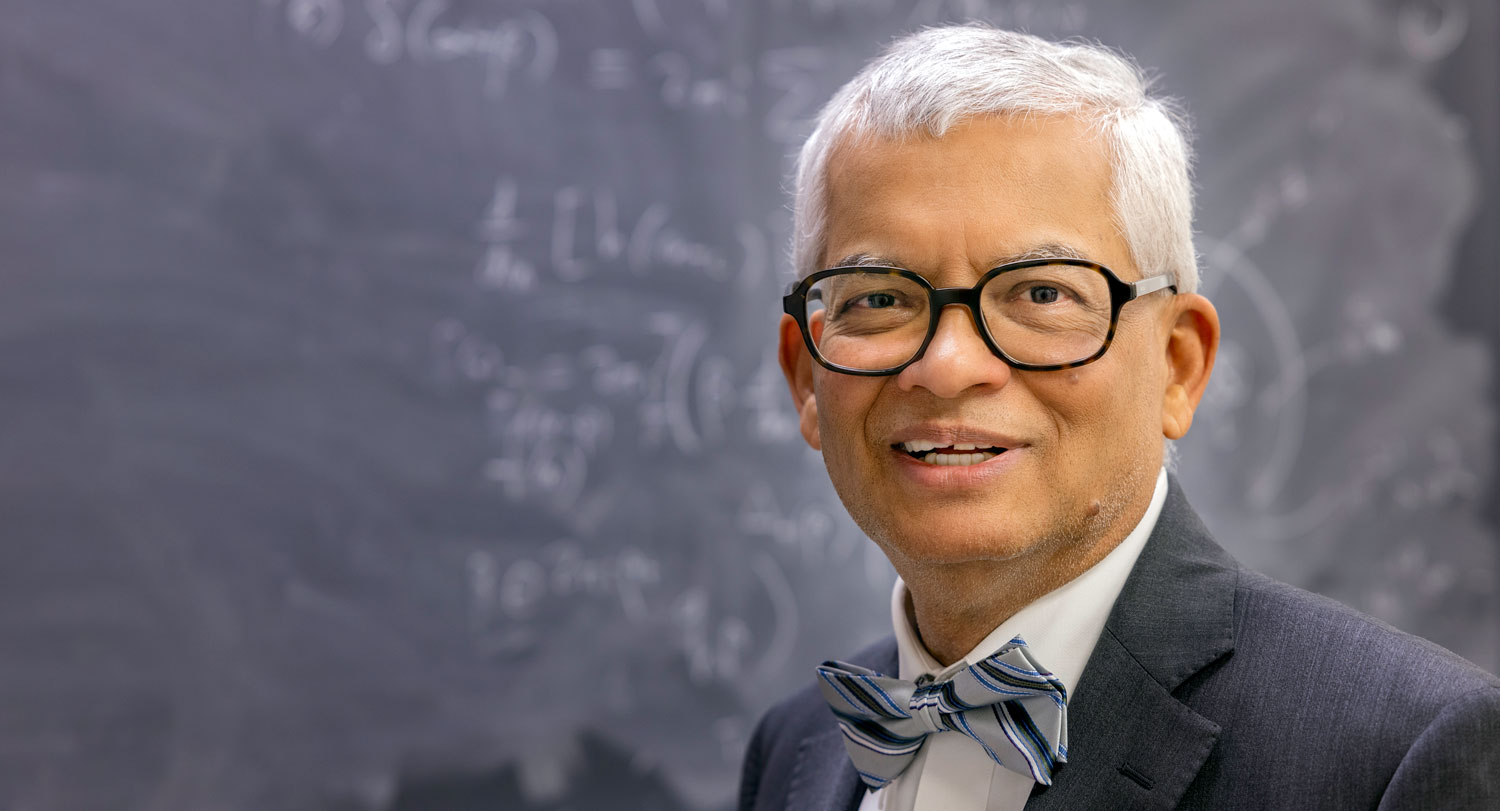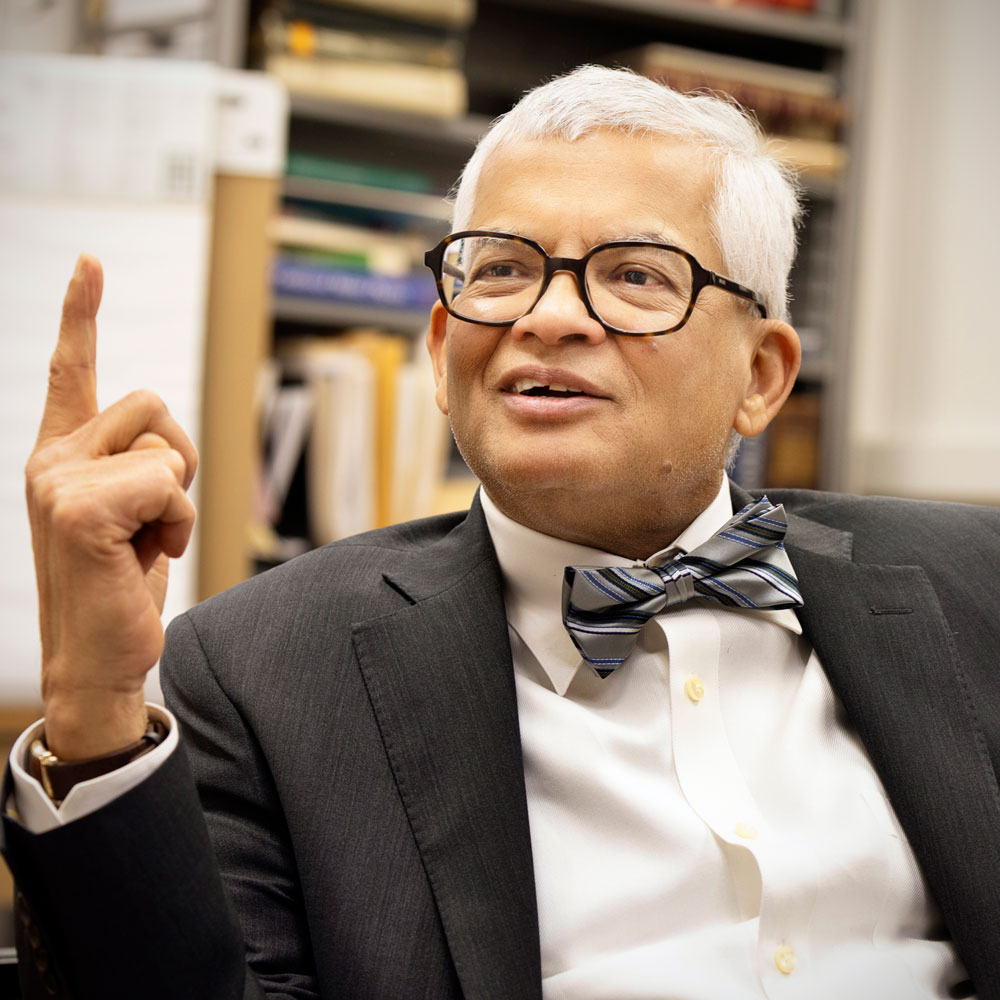
What if up were down, or right were left, or you could somehow divorce a magnet’s push from its pull? Timir Datta likes to imagine a universe where the laws of physics stand on their head.
That’s not why Datta was named a 2022 American Association for the Advancement of Science Fellow, but if you aim to understand how the longtime physics professor’s mind works, it’s helpful to ponder the questions he ponders. It’s also helpful to understand the breadth of his research.
Datta, who joined the University of South Carolina’s Department of Physics and Astronomy in 1982, is best known for his pioneering work with copper oxide superconductors, which have applications in a range of industries, from transportation and energy to healthcare.
Ask how so-called “high-temperature” superconductors represent an improvement over their precursors, he’ll explain coolants — how liquid nitrogen allows you to cool a superconductor at higher temperatures than helium, and more efficiently. He’ll compare the advantages and disadvantages of copper oxide and ceramic superconductors. He’ll describe a hypothetical next-generation high rise, 200-stories tall, that requires an efficient power transmission system not bound up in miles of cable.
It’s this line of research (plus his prominent role with the American Physical Society and his outreach work with high schools and HBCUs) that likely caught the eye of the AAAS. But if you sit down to discuss his ambitions as a physicist, Datta leans toward pure science — and a theory of electromagnetism that has pulled at his imagination for half a century.
He reaches for a prop. He is always reaching for a prop. This time, it’s a string of small magnetic discs. He separates a pair, hands them to you so you can feel their pull, then has you flip them around so you can feel them repel one another.
Every magnet comes with a north pole and south pole, he explains. Electricity is different: Objects can be positively charged, negatively charged or neutral. And even though magnetism and electricity are aspects of the same phenomenon — a changing electric field creates a magnetic field and vice versa — the two phenomena don’t behave the same way.
So, what would happen if the opposite were true, if the magnet behaved more like its electric counterpart? “I'm not so much wanting to say ‘Eureka!’ I'm more, ‘Why doesn’t the opposite happen?’” Datta explains. “When somebody tells you something is a certain way, there's a certain law of physics, I’m thinking, ‘Yeah, well, could it be flipped?’ That is, what altered laws of physics are possible for a universe to function?"
He has been this way since childhood. His father was an engineer back in India, and Datta remembers sitting in his lap, watching Dad draw a diagram of a generator to explain how electricity is produced. Later, he was drawn to magnets, which push and pull in equal measure. The underlying mysteries of polarity had a similar push-and-pull effect on Datta, who found himself wrestling with whys and what ifs.
“I always was inquisitive,” he says. “With the magnet I asked, ‘Why is it a magnet comes with two pieces but electricity just one?’ That was my question. Then I asked, ‘Is it possible to have a universe where magnetism can be separated?’”
He fixed on this last question while doing a post-doc at the University of North Carolina Chapel Hill, and it has occupied a corner of his mind ever since. “This still intrigues me. Nobody knows the answer,” he says. “But I think I'm getting a little bit more answers than I did 50 years ago.”
If this is starting to sound like science fiction, you’re reading him wrong. “I don’t like science fiction,” says Datta. “I like fiction but not science fiction. I like real science.” He also likes philosophy and is as likely to namedrop Immanuel Kant as Sir Isaac Newton.
For his next prop, he pulls out a plastic glove and asks you to consider the concept of “handedness” that so puzzled the 18th century German philosopher. He slips the glove on his right hand, uses a Sharpie to mark the palm with a P, takes the glove off and turns it over. Our hands may appear symmetrical, he explains, but no matter how you turn the glove, it only fits the right hand — unless he turns it inside out.
“This was pointed out by Kant, the incongruence of nature,” he says. “Handedness is not symmetrical; it's orientable. Our world, like the universe we live in, is orientable. My thought is that the electromagnetism that we live in has chosen one-handedness. If we include positive and negative electrical charges, along with positive and negative poles of magnetism, you can fool around with the mathematical laws of electromagnetism. But when these new equations are solved, we will find that only the one hand solution exists.”
This propensity to “fool around,” whether with the equations in his head or in conversation with other physicists, drives him in the lab. In the 1990s, encouraged by prominent scientists in his field, it also drove a polarizing experiment. The essential question: When a conductor is placed in a gravitational field like Earth's, do the electrons inside the conductor rise or do they fall?
He produces a gold-plated drift tube, essentially an enclosed cylinder in which the behavior of electrons can be analyzed in the absence of external forces. He then summarizes an earlier experiment conducted by another prominent physicist who wanted to demonstrate that quantum objects like electrons fall down, just like Newton’s apple.
But when the electrons dropped into his drift tube enclosed by a conductor did not free fall as expected, the physicist concluded that a negative-charged electron will always sink to the bottom of the conducting material of the tube and, by repulsion, prevent the dropped electron from falling.
Datta’s preliminary results, however, suggested the opposite: Electrons inside a conductor seemed to defy Newton’s laws of physics and actually go up. This generated buzz (including praise in the pages of MIT Technology Review) but also skepticism. If replicated, these results might upend our entire understanding of gravity. “I caught a lot of flak,” Datta says with a laugh.
But that’s science. Twenty-five years later, with encouragement from his late friend, Nobel Prize-winning physicist Philip Anderson, he hopes to revisit the experiment on a larger scale. He hasn’t lost sight of superconductor research, of course; he just takes a broad view — and his imagination is constantly provoked.
On the edge of his desk sits a tray of seashells, specimens collected at Hilton Head. He picked them up for their beauty — he enjoys the natural world — but he is also intrigued by their shapes and what they suggest about the larger universe. He shrugs when you ask about them but then examines a small, channeled whelk and traces the shell’s spiraled tip with his finger: “See? There it is again, the one-handedness of nature.”
It’s hardly a new discovery, but Datta’s delight speaks to his philosophy of inquiry and his basic motivation as a scientist. “Physics, to me, is not just facts,” he says. “To me, the question is always, ‘Did it give me wisdom that I didn't have before?’ It’s not just about knowledge but wisdom.”
